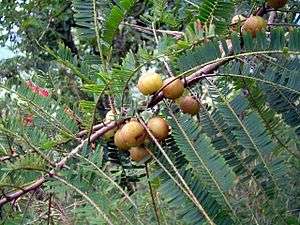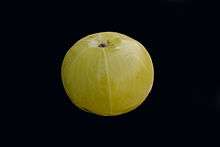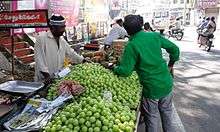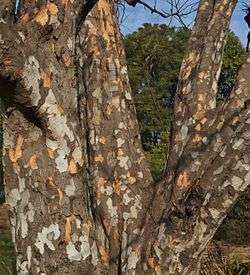Phyllanthus emblica
| Phyllanthus emblica | |
|---|---|
 | |
| Plant | |
 | |
| Fruit | |
| Scientific classification | |
| Kingdom: | Plantae |
| Clade: | Angiosperms |
| Clade: | Eudicots |
| Clade: | Rosids |
| Order: | Malpighiales |
| Family: | Phyllanthaceae |
| Genus: | Phyllanthus |
| Species: | P. emblica |
| Binomial name | |
| Phyllanthus emblica | |
| Synonyms[2] | |
| |
Phyllanthus emblica, also known as emblic,[1][3] emblic myrobalan,[1] myrobalan,[3] Indian gooseberry,[1][3] Malacca tree,[3] or amla[3] from Sanskrit amalaki is a deciduous tree of the family Phyllanthaceae. It has edible fruit, referred to by the same name.
Plant morphology and harvesting
The tree is small to medium in size, reaching 1–8 m (3 ft 3 in–26 ft 3 in) in height. The branchlets are not glabrous or finely pubescent, 10–20 cm (3.9–7.9 in) long, usually deciduous; the leaves are simple, subsessile and closely set along branchlets, light green, resembling pinnate leaves. The flowers are greenish-yellow. The fruit is nearly spherical, light greenish yellow, quite smooth and hard on appearance, with six vertical stripes or furrows.
Ripening in autumn, the berries are harvested by hand after climbing to upper branches bearing the fruits. The taste of Indian emblic is sour, bitter and astringent, and it is quite fibrous. In India, it is common to eat emblic steeped in salt water and red chilli powder to make the sour fruits palatable.
Culture and religion
_fruit_with_young_leaves_%26_flower_buds_at_Jayanti%2C_Duars%2C_West_Bengal_W_Picture_045.jpg)
The tree is considered sacred by Hindus as a deity, Vishnu, is believed to dwell in it. The tree is worshipped on Amalaka Ekadashi.
In other Hindu beliefs, amla is said to have originated from the drops of Amrit which spilled on earth accidentally, because of the fight of gods and demons after ksheera sagar manthan. This religious belief makes claims that it almost cures every disease and is also good in extending the longevity of life.
In the Sanskrit Buddhist tradition, half an amalaka fruit was the final gift to the Buddhist sangha by the great Indian emperor Ashoka. This is illustrated in the Ashokavadana in the following verses:
"A great donor, the lord of men, the eminent Maurya Ashoka, has gone from being lord of Jambudvipa [the continent] to being lord of half a myrobalan" (Strong, 1983, p. 99).[4] This deed became so famous that a stupa was created to mark the place of the event in modern-day Patna and was known as the Amalaka stupa.
According to Hindu tradition, Adi Shankara of Kerala composed and recited the Kanakadhara stotram in praise of Mahalakshmi to make a poor Brahmin lady get wealth, in return for a single amla presented to him as bhiksha on an auspicious dwadashi day.
According to a Tamil legend, Avvaiyar, a female poet, ethicist and political activist of the Sangam period was gifted with one nellikkai by King Athiyaman to give her long life.
_-_Oct_2010.jpg)
In Theravada Buddhism, this plant is said to have been used as the tree for achieving enlightenment, or Bodhi by twenty first Buddha named Phussa Buddha.[5]
In Indian temple architecture, an Amalaka, is a stone disk, usually with ridges on the rim, that sits atop a temple's main tower (Shikhara). The shape of the amalaka is thought to have been inspired by the fruit of the amla tree.
Antioxidants
In 2010, a study published by the US National Library of Medicine National Institutes of Health found that Alma (Indian Gooseberries) had the highest content of antioxidants compared to the other 278 fruits and fruit products and 303 vegetables and vegetable products that were studied. Dried Amla had a score of 261.5 mmol/100g compared to blueberries (often known as a powerful antioxidant) of 3.5 mmol/100g[6]
Traditional uses

Traditional medicine
In traditional Indian medicine, dried and fresh fruits of the plant are used. All parts of the plant are used in various Ayurvedic/Unani medicine (Jawarish amla) herbal preparations, including the fruit, seed, leaves, root, bark and flowers.[7] According to Ayurveda, amla fruit is sour (amla) and astringent (kashaya) in taste (rasa), with sweet (madhura), bitter (tikta) and pungent (katu) secondary tastes (anurasas).[7] Its qualities (gunas) are light (laghu) and dry (ruksha), the postdigestive effect (vipaka) is sweet (madhura) and its energy (virya) is cooling (shita).[8]
According to Ayurveda, amla balances all three doshas (fundamental bodily bio-elements) - pitta, vāta and kapha. While amla is unusual in that it contains five out of the six tastes recognized by Ayurveda, it is most important to recognize the effects of the "virya", or potency, and "vipaka", or post-digestive effect. Considered in this light, amla is particularly helpful in reducing pitta because of its cooling energy.[7] It also balances both pitta and vāta by virtue of its sweet taste. The kapha is balanced primarily due to its drying action. It may be used as a rasayana (rejuvenative) to promote longevity, and traditionally to enhance digestion (dipanapachana), treat constipation (anuloma), reduce fever (jvaraghna), purify the blood (raktaprasadana), reduce cough (kasahara), alleviate asthma (svasahara), strengthen the heart (hrdaya), benefit the eyes (chakshushya), stimulate hair growth (romasanjana), enliven the body (jivaniya), and enhance intellect (medhya).[7][8]
In Ayurvedic polyherbal formulations, Indian gooseberry is a common constituent, and most notably is the primary ingredient in an ancient herbal rasayana called Chyawanprash.[9] This formula, which contains 43 herbal ingredients as well as clarified butter, sesame oil, sugar cane juice, and honey, was first mentioned in the Charaka Samhita as a premier rejuvenative compound.[10][11]
Culinary use
Pratapgarh is one of the largest producers and suppliers of Indian gooseberries. In this region, the fruit is commonly pickled with salt, oil, and spices. The amla fruit is eaten raw or cooked into various dishes. In Pratapgarh, tender varieties are used to prepare dal (a lentil preparation), and amle ka murabbah, a sweet dish made by soaking the berries in sugar syrup until they are candied. It is traditionally consumed after meals.
In the Batak area of Sumatra, Indonesia, the inner bark is used to impart an astringent, bitter taste to the broth of a traditional fish soup known as holat.[12]
Other uses
Popularly used in inks, shampoos and hair oils, the high tannin content of Indian gooseberry fruit serves as a mordant for fixing dyes in fabrics.[7] Amla shampoos and hair oil are traditionally believed to nourish the hair and scalp and prevent premature grey hair.[13]
Chemical constituents
Although these fruits are reputed to contain high amounts of ascorbic acid (vitamin C), up to 445 mg per 100 g,[14] the specific contents are disputed, and the overall bitterness of amla may derive instead from its high density of ellagitannins,[9] such as emblicanin A (37%), emblicanin B (33%), punigluconin (12%) and pedunculagin (14%).[15] It also contains punicafolin and phyllanemblinin A, phyllanemblin other polyphenols, such as flavonoids, kaempferol, ellagic acid, and gallic acid.[9][16]
Gallery
_new_leaves_at_Jayanti%2C_Duars%2C_West_Bengal_W_Picture_039.jpg)
New leaves _at_Jayanti%2C_Duars%2C_West_Bengal_W_Picture_045.jpg)
Flowering twigs _trunk_at_Jayanti%2C_Duars%2C_West_Bengal_W_Picture_041.jpg)
Tree trunk 
Bark of the Indian goosebery
See also
| Wikimedia Commons has media related to Phyllanthus emblica. |
- Emblicanin
- Triphala, an Ayurvedic mixture containing amla
References
- 1 2 3 4 "Phyllanthus emblica". Germplasm Resources Information Network (GRIN). Agricultural Research Service (ARS), United States Department of Agriculture (USDA). Retrieved 2008-03-06.
- ↑ "The Plant List: A Working List of All Plant Species". Retrieved 14 July 2014.
- 1 2 3 4 5 Lim, T.K. (2012). "Phyllanthus emblica". Edible Medicinal And Non-Medicinal Plants. Springer Netherlands. pp. 258–296. doi:10.1007/978-94-007-4053-2_37#page-1.
- ↑ Strong, J. S. (1983) The Legend of King Ashoka, New York: Princeton University Press
- ↑ Buddha: His Life, His Teachings, His Order: Together with the History of the Buddhism, Manmatha Nath Dutt, Society for the resuscitation of Indian literature, 1901, p. 3
- ↑ https://www.ncbi.nlm.nih.gov/pmc/articles/PMC2841576/
- 1 2 3 4 5 Caldecott T. Amalaki
- 1 2 National R&D Facility for Rasayana - Amalaki
- 1 2 3 Dharmananda S. Emblic Myrobalans: Amla, Institute of Traditional Medicine
- ↑ Samhita C. Ed., translation by the Shree Gulabkunverba Society, Volume 4. Chikitsa Sthana, Jamnagar, India: 1949
- ↑ Indian Ministry of Health and Family Planning. The Ayurvedic Formulary of India. Part I. 1st ed. Delhi, 1978.
- ↑ de Clercq, F. S. A. (1909). Nieuw Plantkundig Woordenboek voor Nederlandsch Indië. Amsterdam: J. H. de Bussy. p. 303.
- ↑ Pole, Sebastian (2006). Ayurvedic Medicine: The Principles of Traditional Practice. Singing Dragon. pp. 126–127. ISBN 978-1-84819-113-6.
- ↑ Tarwadi K, Agte V (Aug 2007). "Antioxidant and micronutrient potential of common fruits available in the Indian subcontinent". Int J Food Sci Nutr. 58 (5): 341–9. doi:10.1080/09637480701243905. PMID 17558726.
- ↑ Bhattacharya, A.; Chatterjee, A.; Ghosal, S.; Bhattacharya, S. K. (1999). "Antioxidant activity of active tannoid principles of Emblica officinalis (amla)". Indian journal of experimental biology. 37 (7): 676–680. PMID 10522157.
- ↑ Habib-ur-Rehman, Yasin KA, Choudhary MA; et al. (Jul 2007). "Studies on the chemical constituents of Phyllanthus emblica". Nat. Prod. Res. 21 (9): 775–81. doi:10.1080/14786410601124664. PMID 17763100.